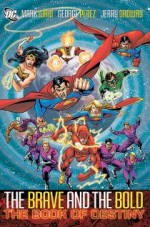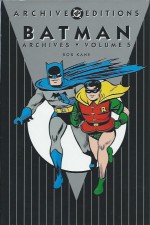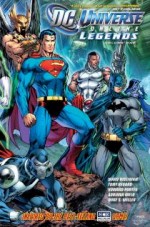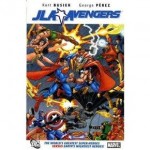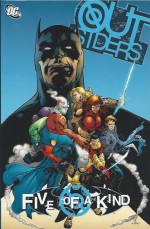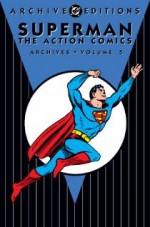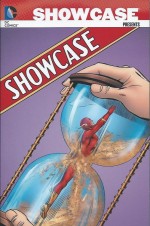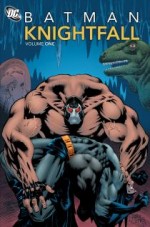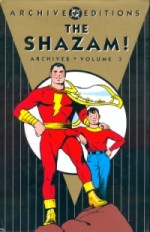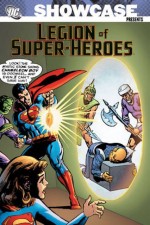
By James Shooter, E. Nelson Bridwell, Cary Bates, Curt Swan, J. Winslow Mortimer, George Tuska, Dave Cockrum, Murphy Anderson, & various (DC Comics)
ISBN: 978-1-4012-2185-0
Once upon a time, a thousand years from now, a band of super-powered kids from a multitude of worlds took inspiration from the greatest legend of all time and formed a club of heroes. One day those Children of Tomorrow came back in time and invited their inspiration to join them…
Thus began the vast and epic saga of the Legion of Super-Heroes, as first envisioned by writer Otto Binder & artist Al Plastino when the many-handed mob of juvenile universe-savers debuted in Adventure Comics #247 (April 1958) just as the revived superhero genre was gathering an inexorable head of steam in America. Since that time the fortunes and popularity of the Legion have perpetually waxed and waned, with their future history tweaked and rebooted, retconned and overwritten over and over again to comply with editorial diktat and popular fashion.
This sturdy, drama-drenched fourth massive monochrome compendium gathers a chronological parade of futuristic delights from June 1968 to September 1970, originally seen in Adventure Comics #369-380 and the reprint issue #403, plus back-up tales from Action Comics #378-392 – a time when the superhero genre again dipped in popularity. Also included in this enchanting tome are the tentative first forays of the team’s slow revival as an alternating back-up feature in Superboy with game-changing exploits from issues #172-173, 176, 183-184, 188 190 and 191, covering March 1971 to October 1972.
During this period the youthful, generally fun-loving and carefree Club of Champions peaked; having only just evolved into a dedicated and driven dramatic action series starring a grittily realistic combat force in constant, galaxy-threatening peril. Although now an overwhelming force of valiant warriors ready and willing to pay the ultimate price for their courage and dedication, science itself, science fiction and costumed crusaders all increasingly struggled against a global resurgence in spiritual questioning and supernatural fiction…
The main architect of the transformation was teenaged sensation Jim Shooter, whose scripts and layouts (generally finished and pencilled by the astoundingly talented and understated Curt Swan) made the series accessible to a generation of fans growing up with their heads in the Future but as the fashions shifted, the series was unceremoniously ousted from its ancestral home and full-length adventures to become a truncated back-up feature in Action Comics. Typically, that shift occurred just as the stories were getting really, really good and truly mature…
The tense suspense begins with Adventure Comics #369’s ‘Mordru the Merciless!’ (Shooter, Swan & Jack Abel) when the Legion was attacked by their most powerful enemy, a nigh-omnipotent sorcerer the entire assemblage had only narrowly defeated once before.
A sneak attack had shattered the team and only four escaped, using a time bubble to flee to the remote and archaic time-period where Superboy lived. With him came Mon-El, Shadow Lass and Duo Damsel, the last remnants of a once-unbeatable force.
Mordru’s magic was stronger though and even the time-barrier could not daunt him… Even disguised as mere mortals, the fugitive Legionnaires’ courage shone through. When petty gangsters took over Smallville, the teen heroes quashed the parochial plunderers and then opted to return to the 30th century and confront Mordru, only to discover that he’d found them first…
The saga concluded in #370 and ‘The Devil’s Jury!’ wherein the band again broke free and hid in plain sight by temporarily wiping their own memories to thwart the Dark Lord’s probes. Against appalling odds and with only Clark Kent‘s best friend Pete Ross and Insect Queen Lana Lang to aid them, the heroes’ doomed last stand only succeeded when Mordru’s overbearing arrogance caused his own downfall.
Then when the exhausted fugitives got back the future they joyously discovered that Dream Girl and benign sorceress White Witch had undone the deluded Dark Lord’s worst…
Extortion and espionage were the order of the day in #371’s ‘The Colossal Failure!’ when a Legionnaire’s parents were abducted and the hero was forced to botch missions. Ordered to retrain at the high security Legion Academy Colossal Boy was subsequently caught selling the team’s training secrets and cashiered from the organisation…
This issue then offered ‘When Superboy Walked Out on the Legion!’ illustrated by George Papp, wherein hyper-advanced and snobbish aliens threatened Smallville unless Superboy left Earth and joined their band of press-ganged heroes. It took ingenuity, a faux civil war and massive destruction to finally convince the alien autocrats to let the assembled champions return to their own home-worlds…
Colossal Boy’s tale of woe concluded in Adventure #372 when his still-loyal buddies uncovered the cause of the expelled giant’s dilemma and tracked him to a ‘School for Super-Villains!’ (Shooter, Swan & Abel), where the fallen hero was compelled to teach a horde of metahuman rogues all the LSH’s secrets.
Luckily and thanks to the expedited induction of apprentice – ergo unknown – heroes Timber Wolf and Chemical King, the good guys were able to infiltrate and shut down this first incarnation of the Legion of Super-Villains…
Golden Age veteran J. Winslow Mortimer replaced Swan from #373 onwards as ‘The Tornado Twins!’ Don and Dawn Allen ran rings around and generally humiliated the assembled heroes – but all for a very good cause, before ‘Mission: Diabolical!’ in #374 focussed on the future equivalent of organised crime when most of the Legionnaires were ambushed and held hostage by the insidious Scorpius gang.
Hard-pressed by rival outfit Taurus, the mobsters had decided to “recruit†a team of heroes to equal their enemies’ squad of hyper-powered goons, Rogarth, Mystelor, Shagrek, Quanto and Black Mace. Of course, after infiltrating and defeating their foes, the press-ganged kids – Supergirl, Element Lad, Dream Girl, Ultra Boy and Matter-EaterLad – were double-crossed by Scorpius and would have died if not for a fortuitous intervention by the Legion of Substitute Heroes…
Next followed a powerful and devious 2-part thriller in #375-376 which introduced galactic-roving heroes The Wanderers and saw those temporarily-insane-and-evil alien champions battle the United Planets’ metahuman marvels – who were far more concerned with determining who would be crowned ‘The King of the Legion!’
The matter was only relevant because a trans-dimensional challenger had demanded a duel with the “mightiest Legionnaireâ€, but when the dust settled the only hero left standing was chubby comic relief Bouncing Boy…
When the triumphant winner was spirited away to another cosmos he arrived in a feudal wonderland – complete with comely princess – menaced by a terrifying invader. Unfortunately the hero was soon exposed as shape-shifting Durlan Legionnaire Reep Daggle and not the human Chuck Taine, but he manfully overcame his abductors’ initial prejudice and defeated the usurper threat Kodar. The freakish victor even won the heart of Princess Elwinda before being tragically rescued and whisked back across a permanently sealed dimensional barrier by his legion buddies who mistook a Royal Wedding for ‘The Execution of Chameleon Boy!’
A welcome edge of dark and bitter cynicism was creeping into Shooter’s stories, and ‘Heroes for Hire!’ (pencilled by Mortimer and inked by Jack Abel) saw the team begin charging for their unique services, but it was only a brilliant ploy to derail the criminal career of Modulus, an avatar of sentient living planet Modo who had turned the world into an unassailable haven for the worst villains of the galaxy…
Issue #378 started another tense and moving 2-parter which began when Superboy, Duo Damsel, Karate Kid, Princess Projectra and Brainiac 5 were poisoned and found themselves with only ‘Twelve Hours to Live!’
With no cure possible the quintet separated to spend their last day in the most personally satisfying ways they could – from sharing precious moments with soon-to-be bereaved family to K-Kid’s one-man assault on the Fatal Five – only to reunite in their final moments and die together…
The incredible conclusion began when a hyper-advanced being calling itself a Seeron froze time and offered to cure the practically dead victims – but only if new arrivals Ultra Boy, Phantom Girl, Chameleon Boy, Timber Wolf, Star Boy, Lightning Lad and Chemical King returned to his universe and defeated an invasion by brutes invulnerable to all the mighty mental powers of the intellectual overlords…
However even as the shanghaied Legionnaires triumphed and returned, their comrades had been found and afforded the honour of ‘Burial in Space!’…
Happily a brilliant last-minute solution enabled the dead to rise just in time to lose their long-held position in Adventure Comics as changing tastes and shrinking sales prompted an abrupt change of venue.
‘The Legion’s Space Odyssey!’ (# 380 dated May 1969, by Shooter, Mortimer & Abel) saw a select band of Legionnaires teleported to the barren ends of the universe and laboriously battle their way home against impossible odds, which included the “death†of Superboy and persistent sabotage by the Legion of Super-Pets.
Of course there was a perfectly rational and reasonable excuse for the devious scheme and the tale is best remembered by fans for being the mission on which Duo Damsel and Bouncing Boy first got together…
From #381 onwards Adventure was filled with the 20th century exploits of Supergirl whilst the LSH took over her secondary spot in Action Comics, beginning with a reprint in #377 which is not included here.
Original shorter ‘Tales of the Legion of Super-Heroes’ began in #378 (July 1969) with ‘The Forbidden Fruit!’ by Shooter, Mortimer & Mike Esposito wherein Timber Wolf was deliberately addicted to a hyper-narcotic lotus in a bold scheme to turn the entire team into pliable junkies. Fortunately the hero’s true love for Light Lass allowed him to overcome his awful burden, whilst in #379’s ‘One of us is an Impostor’, E. Nelson Bridwell, Mortimer & Murphy Anderson offered a clever mystery yarn to baffle Mon-El, Dream Girl, Element Lad, Shadow Lass and Lightning Lad when thermal thug Sunburst and a clever infiltrator threatened to tear the team apart from within…
Duo Damsel declared war on herself in #380 when her other body fell under the sway of an alien Superboy and turned to crime, leaving only Bouncing Boy to clean up the psychological mess of ‘Half a Legionnaire?’ (Shooter, Mortimer & Abel) whilst in #381, Matter-Eater Lad revealed his lowly origins and dysfunctional family to lonely Shrinking Violet and ended up ‘The Hapless Hero!’ battling her absurdly jealous absentee boyfriend Duplicate Boy – the mightiest hero in the universe…
In #382 a covert team comprising Ultra Boy, Karate Kid, Light Lass, Violet and Timber Wolf attempted to quell a potential super-robot arms-race and found that to succeed they might have to ‘Kill a Friend to Save a World!‘, after which the still-heartbroken Durlan found an Earthly double of his lost love Elwinda.
However when he morphed into her ideal man he quickly saw the folly of ‘Chameleon Boy’s Secret Identity!’ – a true tear-jerker with the hint of a happy ending from Bridwell, Mortimer & Abel.
Shooter left his perfect job with #384 but signed off in style with his landmark ‘Lament for a Legionnaire!’ With art misattributed to Mortimer but in fact a welcome fill-in job by the superb Curt Swan & Abel, it told how Dream Girl’s infallible prophecy of Mon-El’s demise came true whilst his shocking resurrection introduced a whole new thrilling strand to the Lore of the Legion.
Bridwell, Mortimer & Abel showed a vengeance-crazed killer’s quest for ultimate retribution fail in ‘The Fallen Starboy!’ and then crafted Action Comics #386’s ‘Zap Goes the Legion!’ wherein cunning female foe Uli Algor believed she had outthought and outfought the juvenile agents of justice but had forgotten one crucial detail…
Then in #387 the creators delightfully added a touch of wry social commentary when the organisation had to downsize and lay off a Legionnaire for tax purposes after the government declared that the team had ‘One Hero Too Many!’
Action #388 was an all-reprint Supergirl giant, but the now revenue-compliant Club of Heroes returned in #389 with ‘The Mystery Legionnaire!’ by Cary Bates, Mortimer & Abel, which explained how robot dictator Klim was defeated by a hero who didn’t exist, whilst Bridwell’s ‘The Tyrant and the Traitor’ in #390 reflected the political turmoil of the 1970’s with a tale of guerrilla atrocity, destabilising civil war and covert regime change.
The Legion Espionage Squad was tasked with doing the dirty work, but even Chameleon Boy, Timber Wolf, Karate Kid, Brainiac 5 and Saturn Girl were out of their depth and only ‘The Ordeal of Element Lad!’ in the next issue saved the undercover unit from ignominious failure and certain death.
Action #392 (September 1970) temporarily ended the feature’s unbroken run in a low-key but gripping yarn from Bates, Mortimer & Abel which included alternate dimensions and preposterous testing of ‘The Legionnaires that Never Were!’
The Frantic Futurians weren’t gone too long. In 1971 a concerted push to revive the Teen Tomorrow Warriors began with the March-dated Superboy # 172 and ‘Brotherly Hate!’ by Bridwell & George Tuska. The sharp, smart yarn detailed the convoluted origins of twins Garth and Ayla Ranzz AKA Lightning Lad and Light Lass and their troubled relationship with older brother Mekt – the deadly outlaw Lightning Lord…
At the same time Adventure Comics #403 (April 1971) was released; an all-Legion reprint special which also included new ‘Fashions from Fans’ reinterpreted by Bridwell, Ross Andru & Esposito as well as a comprehensive ‘Diagram of Legion Headquarters Complex’, included here for your delight and delectation…
Some of those fan-costumes – generally the skimpier ones designed for the girl heroes – were adopted for the ongoing backups appearing in Superboy, which continued the comeback with ‘Trust Me or Kill Me!’ in #173 by Bates & Tuska. In that tense tale Superboy had to devise a way to determine which Cosmic Boy was his true friend and which a magical duplicate wrought by malefic Mordru…
The origin of Invisible Kid and the secrets of his powers were examined when a crook duplicated the boy genius’ fadeaway gifts in #176’s ‘Invisible Invader!’, whilst Bates, Tuska & Vince Colletta reported on the ‘War of the Wraith-Mates!’ in #183 when energy entities renewed an eons-old war of the sexes by possessing Mon-El, Shadow Lass, Karate Kid and Princess Projectra.
Superboy #184 hinted at the days of greatness to come with ‘One Legionnaire Must Go!’ Matter-Eater Lad was framed and replaced by his own little brother in a tale by Bates, but the big advance was the inking of LSH fanatic Dave Cockrum over Murphy Anderson’s pencils. The neophyte artist would gradually transform the look, feel and fortunes of the Legion before moving to Marvel and doing the same with an almost forgotten series entitled X-Men…
With issue #188’s Bates scripted ‘Curse of the Blood-Crystals!’ (July 1972), Anderson began inking Cockrum; the sixth stunning back-up tale of a now unstoppable Legion revival that would eventually lead to the team taking over the entire comicbook. This clever yarn of cross-and-double-cross found a Legionnaire possessed by a magical booby-trap and forced to murder Superboy – but which of the two dozen heroes is actually the prospective killer…?
Superboy #190 featured ‘Murder the Leader!’ as the Fatal Five attacked during the election of a new Legion Commander and rival candidates Saturn Girl and Mon-El had to work together if either was to take the top job, after which this volume concludes with the stunning thriller ‘Attack of the Sun-Scavenger!’ by Bates & Cockrum from #191.
In a staggering burst of comics brilliance, the manic solar scoundrel Dr. Regulus again attacked Sun Boy and his Legion comrades, using his own death as the key to ultimate victory…
The Legion is unquestionably one of the most beloved and bewildering creations in funnybook history and largely responsible for the growth of the groundswell movement that became American Comics Fandom. Moreover, these scintillating and seductively addictive stories – as much as Julie Schwartz’s Justice League or Marvel’s Fantastic Four– fired up the interest and imaginations of generations of readers and underpinned the industry we all know today.
If you love comics and haven’t read this stuff, you are the poorer for it and need to enrich your future days as soon as possible.
© 1968-1972, 2010 DC Comics. All Rights Reserved.

